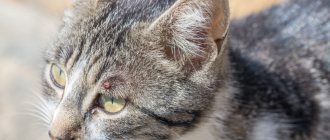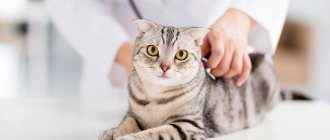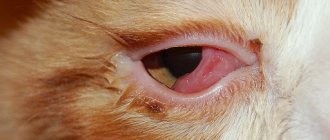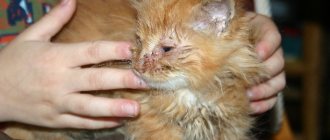If you experience all the unpleasant symptoms of a cold or flu: cough, runny nose and other ailments, then it is very likely that you will have to suffer with your eyes; they may become red, swollen and watery. Alas, this means that conjunctivitis is a bonus to your cold. This is one of the same viruses that cause seasonal illnesses such as colds and flu.
How did the infection get into the eyes? Everything is quite simple: let’s say that you have a cold, accompanied by a severe runny nose. You blow your nose, and then inadvertently rub your eyelid - that’s it, the virus has got into your eyes and wait for conjunctivitis.
Tear production as a variant of the physiological norm
In itself, the release of fluid from the lacrimal canals cannot be considered a pathological phenomenon, since in some cats this process is normal. Basic knowledge about the characteristics of your favorite breed will help the owner understand the reasons why a cat’s eyes are watery.
If the animal has no visible damage to the eyes, there is no swelling, a normal reaction to light remains, and tearing does not cause visible discomfort, the cat is most likely healthy.
Anatomically determined lacrimation
Some cats have tears coming from their eyes due to the structure of their skull or for hereditary reasons.
Persian cats take first place on this list. The Iranian breed is often referred to with the prefix “the most”: long-haired, ancient, domestic. She can also be called “the most whiny” - the Persian cat’s eyes are constantly watering. The animal belongs to the group of brachycephals, in which the width of the head is greater than its length. Due to the small depressed and upturned nose, the cat's tear ducts are deformed, which causes epiphora - constant moisture. This also includes Himalayan cats and exotics.
Scottish Fold and British Shorthair cat breeds are also included in the brachycephalic category. True, their muzzles are not as flat as those of the Persians, so the nasolacrimal ducts are not twisted, but shortened.
The “youngest” representative of this group is the curly-haired Selkirk Rex. Persians, British and exotics took part in the selection of the breed.
Important! For all of these groups, copious secretion of sputum from the canals is a normal and naturally programmed phenomenon. A cat may have tears in only one eye, or one at a time, or both eyes together with varying degrees of intensity. These animals need constant hygienic treatment of watery eyes, otherwise serious problems with hair and skin begin.
Morning tears
If your cat has tears streaming from his eyes in the morning, this is a safe and completely normal occurrence. After sleep, the body is cleansed, clots are removed along with tears, and the cornea is moisturized. Most often, cats wash themselves and clean their eyes. If necessary, the owner can treat untidy crusts in the corners with a cotton swab dipped in a special solution.
Kittens have tears
Tearing in kittens can be caused by several reasons. At an early age, especially before the first vaccination, the baby’s body cannot cope with pathogenic microorganisms on its own. Therefore, discharge from a kitten's eyes may indicate the presence of an infection. Also, causes of excessive lacrimation can be infections with parasites, colds, injuries and allergic reactions.
Penetrating wounds
The species diversity of penetrating injuries to the organ of vision is quite large, so they are divided into three groups with seriously different injuries. The largest percentage of penetrating wounds occurs in lesions in which the wounding object cuts the outer eye membranes (sclera and cornea) completely. Such damage is considered extremely dangerous, since it can seriously reduce the visual functions of the eye (often to the point of blindness) or cause the death of a paired healthy eye.
Signs and symptoms of pathological lacrimation
Pathological lacrimation in cats is most often accompanied by the following symptoms:
- the pupil dims or changes color;
- darkened iris;
- injuries to the eye or the area around it: scratches, abrasions, bruises;
- change in the shape of the eyeball;
- inflamed eyelids;
- nasal discharge, the appearance of a purulent substance;
- swelling on the face;
- increased body temperature;
- lack of reaction or delayed response to changes in light flux;
- a cloudy, opaque liquid is released from the eye, which leaves a dirty sticky mark on the animal’s fur.
You can treat a cat at home only after it has been examined by a veterinarian.
Cat bites are more likely to become infected than dog bites
Although cat bites are less common than dog bites, scratches are not uncommon. And those wounds inflicted by cats are five times more likely to cause infection, inflammation and suppuration of wounds than dog bites. This happens for two reasons.
- First, cat teeth are thin and sharp, so they penetrate tissue, tendon sheaths and joints of the human body much deeper than dog teeth, which are usually blunter and wider. With their bites they introduce infection into the wound.
- Secondly, cats tend to breathe through their nose. This means that their mouths are closed most of the time, which allows more bacteria to accumulate in the mouth and is more dangerous to humans.
Possible reasons why a cat's eyes are watery
If a cat squints and her eyes water, this may indicate the development of serious pathologies in the animal’s body.
Infection: chlamydia
A very striking example of how the disease, even in asymptomatic manifestations, is accompanied by lacrimation from one eye. At the same time, the animal does not show other signs of illness - the appetite is almost not affected, the temperature remains normal or slightly elevated, but copious mucus already signals danger. After 4-5 days, the process affects the second eye, and later affects the respiratory system. During this time, the sick cat manages to infect everyone around.
The infection is spread by rodents; it reaches the mucous membranes along with food or through contact with a carrier. Kittens can become infected from their mother cat during birth.
As treatment, the veterinarian prescribes a course of antibiotics, ointments and drops.
Infection: feline viral rhinotracheitis
The disease is called “feline pneumonia” due to symptoms similar to the human disease. True, this virus is safe for people; only cats suffer from rhinotracheitis. More often than others, young animals and older animals that have problems with immunity suffer.
In addition to the fact that one or both eyes of the cat are watery and red, rhinotracheitis is accompanied by additional signs:
- inflammation of the conjunctiva;
- clouding of the pupil and blurred vision;
- sneezing and excessive saliva;
- lack of appetite and rapid weight loss;
- lethargy, apathy, other signs of malaise;
- slightly elevated temperature that does not reach critical values.
If you consult a doctor in a timely manner, viral rhinotracheitis in a cat can be treated, but in the absence of help, the animal may lose its sight and even die. The death of a cat is most often caused by other chronic diseases that become active in a weakened body. Therefore, as soon as a cat or small kitten’s eye begins to water, the animal should be immediately shown to a veterinarian.
Eye injuries, foreign bodies, burns
A cat's eyes may become watery due to foreign body penetration, mechanical injuries and burns:
- Head injuries can lead to the onset of inflammatory processes in the nasopharynx. In this case, tearing from the cat’s eyes will be one of the first obvious symptoms.
- The ingress of foreign objects also causes a standard reaction - the cat squints and its eyes water. The person’s responsibility is to help the pet get rid of the harmful effects as quickly as possible, before the object in the eye damages the pupil or eyelid.
- Excessive tearing from the eyes of cats can occur due to burns. In this case, the animal will need emergency veterinary care.
Important! In case of injuries or burns to the eyes, the cat needs emergency assistance from a specialist. To avoid serious complications, you should not treat your pet yourself.
Trichiasis and districhiasis
Both signs cannot even be fully called diseases. We are talking about abnormal eyelash growth when the cornea comes into contact with the hairs. This causes permanent eye injury, which is accompanied by tearing. Without timely help from a veterinarian, the cat may develop conjunctivitis or another inflammatory process.
Other reasons why a cat's eyes are watery
Sometimes the cat squints, and later her eyes begin to water, but after a while the symptoms disappear. This indicates periodic irritants that are not signs of any disease, but if you do not pay attention to them, the process can become regular and move into a more dangerous phase.
The reason for the excessive secretion of tears may be new food, for example, when changing the animal’s diet. Most often, the introduction of new products affects the well-being of small cats - their eyes immediately become red and watery.
Bright lighting, heat, wind or cold can be irritants to a cat's eyes.
Prevention of tearing
Many problems in your pet’s health can actually be avoided if a number of measures are taken in a timely manner.
Animal owners should pay attention to the following points:
- Daily cat care is of great importance, despite the fact that animals “wash themselves”, it does not hurt to additionally wipe your pet’s eyes with a decoction of calendula or other herbs, unsweetened tea, making sure that the liquid is at room temperature;
- periodically (2-3 times a week) the drug Bars, Diamond Eyes, etc. is dripped under the eyelid;
using household and disinfectants, make sure that the pet is not nearby;- when ventilating the rooms where the cat is, they try to prevent drafts in order to avoid the animal catching a cold;
- make sure that the cat does not injure its eyes during walks and games;
- carefully select the diet, excluding foods and feeds that can cause an allergic reaction;
- Vaccinate your pet in a timely manner, which allows you to avoid many diseases.
Don't expect health problems from your pet. Regular visits to the veterinarian will help to promptly identify ophthalmological defects and congenital pathologies.
If a cat of a breed that is at risk lives in the house, then it should be given a lot of attention and constantly monitor the condition of the animal’s eyes.
When to see a doctor
If, as a result of the injury, the cat's eye is red and watery, you should not postpone a visit to the doctor. The sooner the cat receives help, the greater the chance of preserving the animal’s vision.
Important! If there is dirty or purulent discharge from the eyes, the cat should be taken to the vet immediately!
Diagnostics in the clinic
Diagnostic methods for lacrimation in cats involve a simple visual examination and further laboratory tests. The goal is to identify the cause of discharge from the eyes and prescribe treatment if infectious or other diseases are detected. To clarify the diagnosis, stool analysis, scrapings or smears, and hardware examination of the eyes may be required.
First aid
In order to provide first aid, it is extremely important for doctors to know the distinctive signs of penetrating eye lesions. So, without fail, it is necessary:
- Apply a sterile bandage to the victim and inject an antibiotic and tetanus toxoid intramuscularly.
- If possible, immediately send the victim to a specialized hospital, strictly lying down.
It is strictly forbidden to remove foreign bodies yourself (with the exception of particles on the surface of the eye tissue).










